Many people consider salads one of the healthiest foods when trying to eat healthily. Salads are usually packed with veggies, meaning you’ll get lots of fibre and nutrients, except for chicken, tuna, eggs and pasta salads.
Salads without dressing can be tedious. The dressing ingredients that make salads healthier and the ones to avoid are crucial. Depending on your dressing choice, how you top off your salad will either add nutrients or detract from them.

Image Credit: Pexels/Waldemar
Healthy Dressings Don’t Have To Be Creamy
Choosing a salad dressing starts with figuring out if you prefer an oily or creamy one. Bonnie Taub-Dix, a registered dietician, said creamy dressings tend to have more saturated fat than oily dressings. Taub-Dix said saturated fats are less healthy for us than unsaturated fats and should not make up more than 6% of a person’s diet.
If you’re trying to lose weight, Taub-Dix recommends reading the nutrition label on the salad dressing. It includes checking the saturated fat content, sugar, sodium, and calories. Olive oil, for example, contains a higher proportion of unsaturated fats than vegetable oil. Keeping an eye out for five specific ingredients that the dietitians said have little or no nutritional value is worth reading the ingredients list.

Image Credit: Pexels/Tholaal Mohamed
Avoid These Five Ingredients
- Palm Oil
- Sugar
- Salt
- Monosodium Glutamate (MSG)
- Coconut Oil
Taub-Dix said fresh herbs, such as garlic, basil, or thyme, enhance flavor. Herbs are not only flavorful but also full of antioxidants that are good for your heart. It is certainly something that the ingredients listed above cannot claim! You can prevent your greens from becoming calorie-laden sodium bombs by avoiding these common salad dressing ingredients.